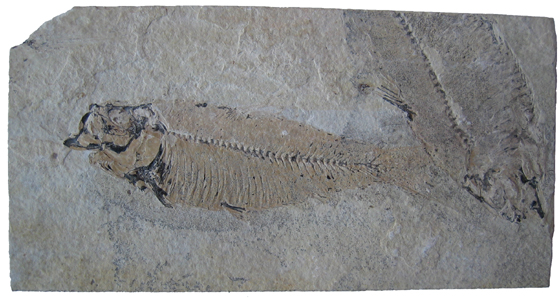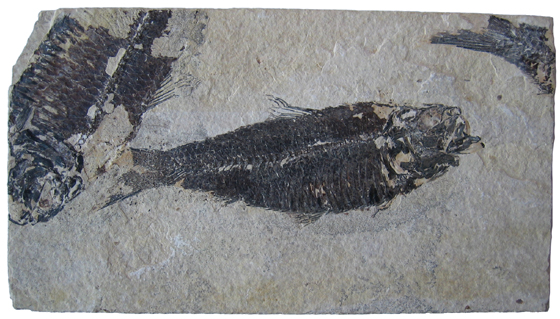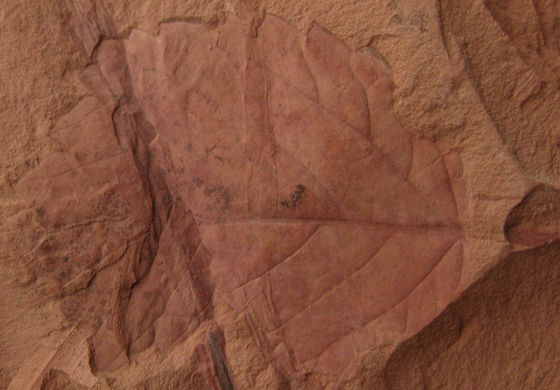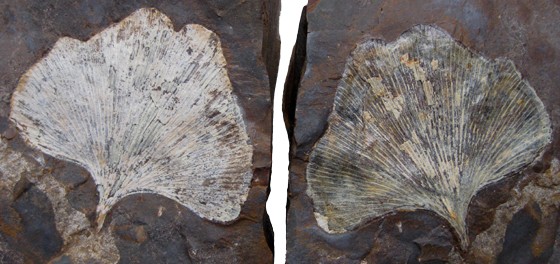
 |
 |
Imprints
& Impressions
  Imprint & Compression of Fish Knightia eocaena Cenozoic; Paleocene; Eocene Green River Formation Kemmerer, Wyoming Complete Fish 12 cm long |
|
| Imprints
are really shallow external molds or voids left by
animal or plant tissue. When the siltstone pictured above
was split
into two slabs the organic matter adhered to one side.
The top
picture represents an imprint in which bones and scales
left a shallow external mold. The lower picture is a compression
because it possess organic residue
left
from scales, original
bone,
and
bone reinforced
with calcite. Compressions retain original or
chemically altered organic material while imprints
do not. Fish
and leaves are often found as imprints and compressions.
Fossil
leaves discovered by splitting bedding planes may
reveal two fossils from a single specimen. The side
with
more organic material is called a compression. The thin
carbon layer on a plant compression is known as a
phytoleim (Cleal & Thomas, 2009, p. 4). The phytoleim
may retain original cuticle, which resists decay.
The cuticle is the protective noncellular waxy covering
of the
epidermis.
When removed and studied the cuticle may reveal the
arrangement of epidermal cells and stomata, which
can sometimes aid in species identification (Tidwell,
1998, p. 27). The
side with little or no organic material is called
an impression (Tidwell, 1998, p. 27; Taylor, Taylor & Krings,
2009, p. 21; Schopf, 1975, p. 37). Sometimes parts
of a specimen are preserved as a compression while
other
parts are an impression. In this case the term adpression
may be used. Adpressions form when the matrix of
a fossil
is soft and the phytoleim has fallen off in some
places (Cleal & Thomas, 2009, p. 4). Compressions and impressions are the most common insect fossil. Insects with organic matter are called compressions, while those with no organic matter are referred to as impressions. For the paleontologist that studies insects, impressions are like casts and molds, which may preserve some relief like pleating on wings (Grimaldi & Engel, 2005, p. 43). This is important because wing venation can be used to identify an insect. Lake
deposits are the most common environment in which leaf
and insect
fossils form. Insects and leaves become trapped in sediments.
As the sediments accumulate the insects and leaves may
decompose leaving behind imprints. As the sediments compact
and hardened into rock the imprints become impression
fossils.
If organic matter remains then a compression fossil has
formed. Even a single specimen can represent both a compression
and
impression.
Many insects
found at
Florissant,
Colorado
are found with their bodies fossilized as
compressions
and
their
wings
as impressions. The body still retains the altered
cuticle, while the wings do not have any organic matter
remaining. | |
 Leaf Imprint or Impression Paleocene Fort Union Formation Big Horn County, Montana 3 cm long x 2.5 cm wide |
|
 Ginkgo adiantoides Paleocene Sentinel Butte Formation Morton Co., North Dakota |
|
The
fossil Ginkgo leaf above represents a part and counterpart.
The fossil on the left formed as a compression and represents
the part (positive
side). The fossil on the right is an impression and represents
the counterpart
(negative side). |
|
Bibliography |
|
Cleal
C.J. & Thomas, B.A. (2009). Introduction to
Plant Fossils. United Kingdom: Cambridge University
Press. Janssen,
R.E. (1979). Leaves and Stems from Fossil Forests:
A Handbook of the Paleobotanical Collections in the
Illinois State Museum. Springfield, Illinois:
Illinois State Museum. Rich P.V., Rich T. H., Fenton, M.A., & Fenton, C.L. (1996). The Fossil Book: A Record of Prehistoric Life. Mineola, NY: Dover Publications, Inc. Schopf,
J.M. (1975). Modes of Fossil Preservation. Review
of Palaeobotany and Palynology, vol 20: pp. 27-53. Tidwell, W.D. (1998). Common Fossil Plants of Western North America. [2nd Ed]. Washington: Smithsonian Institution Press. |
|










